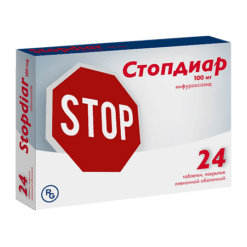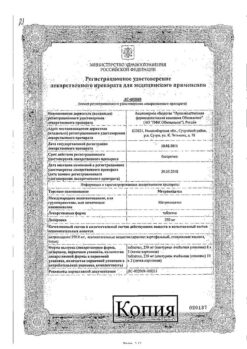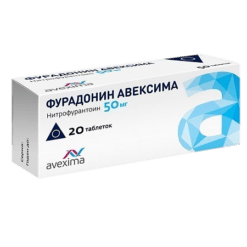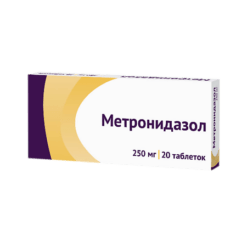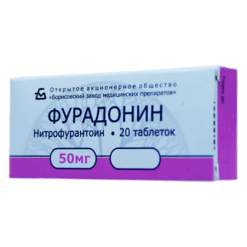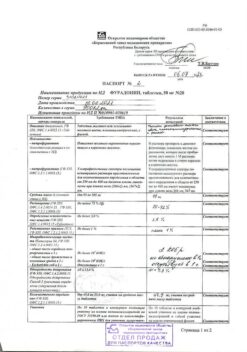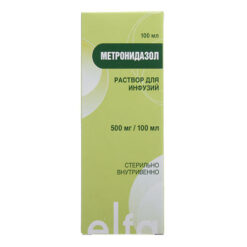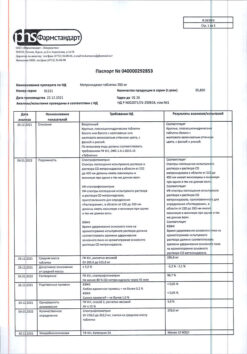No products in the cart.
Metronidazole-ACOS, 5 mg/ml 100 ml
€1.04 €0.95
Description
Metronidazole – Akos is an antimicrobial, antiprotozoal.
A 5-nitroimidazole derivative. Mechanism of action consists in biochemical reduction of 5-nitrogroup by intracellular transport proteins of anaerobic microorganisms and protozoa. The reduced 5-nitrogroup interacts with the DNA of the microbial cell, inhibiting the synthesis of their nucleic acids, which leads to the death of the bacteria.
It is active against Trichomonas vaginalis, Entamoeba histolytica, Gardnerella vaginalis, Giardia intestinalis, Lamblia spp, as well as obligate anaerobes Bacteroides spp. (including Bacteroides fragilis, Bacteroides distasonis, Bacteroides ovatus, Bacteroides thetaiotamicron, Bacteroides vulgatus), Fusobacterium spp, Veillonella spp., Prevotella (P.bivia, P.buccae, P.disiens) and some gram-positive anaerobic microorganisms (Eubacterium spp., Clostridium spp., Peptococcus spp., Peptostreptococcus spp.) The MPC for these strains is 0.125-6.25 µg/ml.
In combination with amoxicillin it shows activity against Helicobacter pylori (amoxicillin suppresses the development of resistance to metronidazole).
Metronidazole is insensitive to aerobic microorganisms and some anaerobes, but in the presence of mixed flora (aerobes and anaerobes) metronidazole acts synergistically with antibiotics effective against common aerobes.
It increases the sensitivity of tumors to radiation, causes sensitization to alcohol (disulfiram-like action), stimulates reparative processes.
Pharmacokinetics
The absorption is high; bioavailability if taken orally is not less than 80%. It has high penetrating capacity, reaching bactericidal concentrations in most body tissues and fluids, including lungs, kidneys, liver, skin, cerebrospinal fluid, brain, bile, saliva, amniotic fluid, abscess cavities, vaginal secretion, seminal fluid, breast milk; passes through the BBB and placental barrier. Distribution volume in adults is approximately 0.55 L/kg, in infants 0.54-0.81 L/kg. Cmax when taken orally is reached after 1 to 3 hours and is 6 to 40 mcg/ml, depending on the dose. Binding to plasma proteins is 10-20%. Cmax in serum after 1 hour is 35.2 µg/ml, after 4 hours – 33.9 µg/ml, after 8 hours – 25.7 µg/ml; Cmin during subsequent administration – 18 µg/ml. Time of reaching Cmax is 30-60 minutes, therapeutic concentration is maintained for 6-8 hours. With normal bile formation, the concentration of metronidazole in bile after IV administration may be significantly higher than in plasma.
In the body about 30-60% of metronidazole is metabolized by hydroxylation, oxidation and glucuronidation. The main metabolite (2-oxymetronidazole) also has antiprotozoal and antimicrobial effects.
The T1/2 in normal liver function is 8 h (6 to 12 h), in alcoholic liver damage is 18 h (10 to 29 h); in neonates born at 28-30 weeks gestation is approximately 75 h, 32-35 weeks – 35 h and 36-40 weeks – 25 h respectively. It is excreted by the kidneys 60-80% (20% unchanged), through the intestines 6-15%. Renal clearance is 10.2 ml/min.
Indications
Indications
Protozoal infections: extraintestinal amebiasis, including amoebic liver abscess, intestinal amebiasis (amebic dysentery), trichomoniasis, giardiasis, balantidiasis, giardiasis, cutaneous leishmaniasis, trichomonas vaginitis, trichomonas urethritis.
Infections caused by Bacteroides spp. (including B.fragilis, B.distasonis, B.ovatus, B.thetaiotaomicron, B.vulgatus): infections of bones and joints, infections of the central nervous system, incl. meningitis, brain abscess, bacterial endocarditis, pneumonia, empyema and lung abscess.
Infections caused by Bacteroides species, including the B.fragilis group, Clostridium species, Peptococcus and Peptostreptococcus: abdominal infections (peritonitis, liver abscess), pelvic infections (endometritis, endomyometritis, fallopian tube and ovarian abscess, vaginal vault infections after surgery), skin and soft tissue infections.
Infections caused by Bacteroides species, including the B.fragilis group, and Clostridium species.
Pseudomembranous colitis (associated with antibiotic use).
Gastritis or duodenal ulcer associated with Helicobacter pylori, alcoholism.
Prevention of postoperative complications (especially interventions on the colon, peri-rectal area, appendectomy, gynecological operations).
Radiation therapy for patients with tumors – as a radiosensitizing agent in cases where tumor resistance is due to hypoxia in tumor cells.
Pharmacological effect
Pharmacological effect
Metronidazole – Akos – antimicrobial, antiprotozoal.
5-nitroimidazole derivative. The mechanism of action is the biochemical reduction of the 5-nitro group by intracellular transport proteins of anaerobic microorganisms and protozoa. The reduced 5-nitro group interacts with the DNA of the microbial cell, inhibiting the synthesis of their nucleic acids, which leads to the death of bacteria.
Active against Trichomonas vaginalis, Entamoeba histolytica, Gardnerella vaginalis, Giardia intestinalis, Lamblia spp., as well as obligate anaerobes Bacteroides spp. (including Bacteroides fragilis, Bacteroides distasonis, Bacteroides ovatus, Bacteroides thetaiotamicron, Bacteroides vulgatus), Fusobacterium spp., Veillonella spp., Prevotella (P.bivia, P.buccae, P.disiens) and some gram-positive anaerobic microorganisms (Eubacterium spp., Clostridium spp., Peptococcus spp., Peptostreptococcus spp.). The MIC for these strains is 0.125–6.25 μg/ml.
In combination with amoxicillin, it is active against Helicobacter pylori (amoxicillin suppresses the development of resistance to metronidazole).
Aerobic microorganisms and some anaerobes are insensitive to metronidazole, but in the presence of mixed flora (aerobes and anaerobes), metronidazole acts synergistically with antibiotics that are effective against common aerobes.
Increases the sensitivity of tumors to radiation, causes sensitization to alcohol (disulfiram-like effect), stimulates reparative processes.
Pharmacokinetics
Absorption is high, bioavailability when taken orally is at least 80%. It has high penetrating ability, reaching bactericidal concentrations in most tissues and body fluids, including lungs, kidneys, liver, skin, cerebrospinal fluid, brain, bile, saliva, amniotic fluid, abscess cavities, vaginal secretions, seminal fluid, breast milk; passes through the BBB and placental barrier. The volume of distribution in adults is approximately 0.55 l/kg, in newborns it is 0.54–0.81 l/kg. Cmax when taken orally is achieved within 1–3 hours and ranges from 6 to 40 mcg/ml, depending on the dose. Plasma protein binding is 10–20%. With intravenous administration of 500 mg over 20 minutes, Cmax in serum after 1 hour – 35.2 mcg/ml, after 4 hours – 33.9 mcg/ml, after 8 hours – 25.7 mcg/ml; Cmin upon subsequent administration is 18 mcg/ml. The time to reach Cmax is 30–60 minutes, the therapeutic concentration is maintained for 6–8 hours. With normal bile formation, the concentration of metronidazole in bile after intravenous administration can significantly exceed the concentration in plasma.
About 30–60% of metronidazole is metabolized in the body through hydroxylation, oxidation and glucuronidation. The main metabolite (2-oxymetronidazole) also has antiprotozoal and antimicrobial effects.
T1/2 with normal liver function – 8 hours (from 6 to 12 hours), with alcoholic liver damage – 18 hours (from 10 to 29 hours); in newborns born at a gestational age of 28–30 weeks – approximately 75 hours, 32–35 weeks – 35 hours and 36-40 weeks – 25 hours, respectively. 60–80% is excreted by the kidneys (20% unchanged), and 6–15% through the intestines. Renal clearance – 10.2 ml/min.
In patients with impaired renal function, after repeated administration, accumulation of metronidazole in the blood serum may occur (therefore, in patients with severe renal failure, the frequency of dosing should be reduced). Metronidazole and its main metabolites are quickly removed from the blood during hemodialysis (T1/2 is reduced to 2.6 hours). During peritoneal dialysis, it is excreted in small quantities.
Special instructions
Special instructions
During the treatment period, ethanol intake is contraindicated (a disulfiram-like reaction may develop: cramping abdominal pain, nausea, vomiting, headache, sudden rush of blood to the face).
With long-term therapy, it is necessary to monitor the blood picture.
If leukopenia develops, the possibility of continuing treatment depends on the risk of developing an infectious process.
The appearance of ataxia, dizziness and any other deterioration in the neurological status of patients requires cessation of treatment.
May immobilize treponemes and lead to a false positive Nelson test result.
Colors urine dark.
When treating trichomonas vaginitis in women and trichomonas urethritis in men, it is necessary to abstain from sexual intercourse. Simultaneous treatment of sexual partners is mandatory. Treatment does not stop during menstruation. After treatment for trichomoniasis, control tests should be carried out during three consecutive cycles before and after menstruation.
After treatment for giardiasis, if symptoms persist, three stool tests should be performed after 3-4 weeks at intervals of several days (in some successfully treated patients, lactose intolerance caused by infestation may persist for several weeks or months, resembling the symptoms of giardiasis).
Active ingredient
Active ingredient
Metronidazole
Composition
Composition
Active ingredients:
metronidazole 5 mg;
Excipients:
sodium chloride,
citric acid monohydrate,
sodium hydrogen phosphate,
water for injections
Pregnancy
Pregnancy
Contraindicated in the first trimester of pregnancy; with caution – in the second and third trimesters of pregnancy.
During lactation it is recommended to stop breastfeeding.
Contraindications
Contraindications
Hypersensitivity, leukopenia (including history), organic lesions of the central nervous system (including epilepsy), liver failure (in case of large doses), first trimester of pregnancy, breastfeeding.
With caution – in the second and third trimesters of pregnancy, renal/liver failure.
Side Effects
Side Effects
From the digestive system: diarrhea, anorexia, nausea, vomiting, intestinal colic, constipation, metallic taste in the mouth, dry mouth, glossitis, stomatitis, pancreatitis.
From the nervous system: dizziness, impaired coordination of movements, ataxia, confusion, irritability, depression, increased excitability, weakness, insomnia, headache, convulsions, hallucinations, peripheral neuropathy.
Allergic reactions: urticaria, skin rash, skin hyperemia, nasal congestion, fever, arthralgia.
From the genitourinary system: dysuria, cystitis, polyuria, urinary incontinence, candidiasis, red-brown coloring of urine.
Local reactions: thrombophlebitis (pain, redness or swelling at the injection site).
Other: neutropenia, leukopenia, flattening of the T wave on the ECG.
Interaction
Interaction
Metronidazole for intravenous administration is not recommended to be mixed with other drugs.
Strengthens the effect of indirect anticoagulants, which leads to an increase in the time of prothrombin formation.
Similar to disulfiram, it causes ethanol intolerance. Concomitant use with disulfiram can lead to the development of various neurological symptoms (the interval between prescriptions is at least 2 weeks).
Cimetidine inhibits the metabolism of metronidazole, which may lead to an increase in its concentration in the blood serum and an increased risk of side effects.
The simultaneous administration of drugs that stimulate microsomal oxidation enzymes in the liver (phenobarbital, phenytoin) can accelerate the elimination of metronidazole, resulting in a decrease in its plasma concentration.
When taken simultaneously with lithium preparations, the concentration of the latter in the plasma may increase and the development of symptoms of intoxication.
It is not recommended to combine with non-depolarizing muscle relaxants (vecuronium bromide).
Sulfonamides enhance the antimicrobial effect of metronidazole.
Storage conditions
Storage conditions
In a dry place, protected from light, at a temperature of 15–25 °C
Shelf life
Shelf life
2 years
Manufacturer
Manufacturer
Sintez, Russia
Additional information
| Shelf life | 2 years |
|---|---|
| Conditions of storage | In a dry, light-protected place at 15-25 °C |
| Manufacturer | Sintez OAO, Russia |
| Medication form | solution for infusion |
| Brand | Sintez OAO |
Related products
Buy Metronidazole-ACOS, 5 mg/ml 100 ml with delivery to USA, UK, Europe and over 120 other countries.



